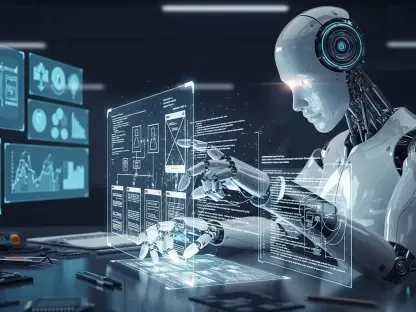The article delves into the contemporary advancements in test automation, focusing on the rising prominence of AI copilots. These AI-driven tools are changing the landscape of software testing, promising to enhance productivity and efficiency while bringing new challenges for testers. By exploring the benefits and drawbacks of AI copilots, the article aims to provide a balanced view of their potential impact on the software testing industry and the roles of QA professionals.
Understanding AI Copilots
Definition and Functionality
AI copilots are sophisticated tools powered by large language models (LLMs) and generative AI that integrate seamlessly into existing software ecosystems. They facilitate several key tasks: generating test cases, producing code snippets, detecting potential issues, and improving overall code quality. These capabilities are achieved through advanced machine learning (ML) algorithms, natural language processing (NLP), and comprehensive analytics.
An AI copilot tailors its suggestions to align with the user’s intent and logic, providing a clear understanding of developers’ objectives. This intelligent assistance results in accelerated code generation, streamlined problem-solving, and simplified test creation. Moreover, AI copilots enhance experimentation with application programming interfaces (APIs) by automatically generating documentation, thus saving considerable time and effort for developers and testers.
How AI Copilots Work
The operation of AI copilots can be broken down into three primary components: integration with code, context analysis, and code generation.
Integration with Code
AI copilots integrate with the developer’s environment, offering context-aware suggestions alongside the code. This integration is achieved through plugins or APIs that connect with widely-used integrated development environments (IDEs) like Visual Studio Code or IntelliJ IDEA. As developers write code, the copilot is constantly analyzing the input, providing relevant insights and assistance. This real-time interaction ensures that developers receive timely feedback and potential improvements directly within their workspace, significantly reducing the back-and-forth traditionally required in software development.
Context Analysis
The copilot’s ability to provide valuable suggestions hinges on its thorough understanding of the project’s context. It reviews various elements such as existing code, comments, and natural language descriptions within the project. This collected information is sent to the copilot’s underlying LLM, which interprets the programmer’s intent and the overall logic of the project. The analysis is not limited to static code; it also considers dynamic aspects like runtime behaviors and interactions with other parts of the application. This comprehensive approach enables the copilot to make more accurate predictions and offer contextually relevant advice.
Code Generation
After processing the context analysis, the copilot predicts the next logical steps a programmer might take and generates appropriate code snippets. These predictions range from simple completions to entire function bodies, depending on the complexity of the task at hand. The generated code is tailored to fit seamlessly with the existing codebase, adhering to coding standards and best practices. By automating this aspect of development, AI copilots reduce manual effort, expedite the coding process, and help avoid common mistakes that can occur with repetitive tasks.
The Importance of AI Copilots in QA Testing
Demand for Quick and High-Quality Software Delivery
In today’s market, the demand for delivering high-quality software swiftly is immense, leading to a shorter software development lifecycle (SDLC). This pressures developers to ensure quick and reliable testing, making AI copilots crucial for efficient QA testing. While traditional non-AI copilots help automate repetitive tasks and manage workflows, AI copilots handle more complex processes such as defect detection and insights generation.
The continuous evolution of AI suggests that the role of AI copilots in QA testing will grow, allowing for more comprehensive and accurate software testing. This will enable companies to manage a higher volume of tests, improving the quality and reliability of their software.
Advantages of AI Copilots for Test Automation
Boosting Productivity
One of the primary advantages of deploying AI copilots in automation testing is the significant boost in productivity. By automating routine tasks, AI copilots free up testers to focus on more complex scenarios that require human intelligence. This shift not only speeds up the testing process but also enhances the quality of the software being developed. With mundane tasks handled by AI, testers can dedicate more time to exploratory testing, verifying edge cases, or ensuring that user experience is optimal.
Precision and Consistency
AI copilots reduce human error in the testing process by automating test generation and execution. This reduces the likelihood of oversight and ensures that all scenarios and tests are thoroughly covered. Additionally, AI copilots deliver consistent results, as automated procedures are executed without fatigue or variation, unlike human testers. The copilot’s ability to perform repetitive tasks without deviation ensures that test cases are executed uniformly every time, bolstering the reliability of testing outcomes.
Adaptive Learning
AI copilots improve over time by learning from past data. As they collect more data, they become better at predicting potential issues and providing accurate results, making the testing process more reliable and efficient. This learning aspect is particularly beneficial in regression testing, where frequent software updates can introduce new issues. By analyzing previous test results and identifying patterns, AI copilots can predict which areas of the application are most likely to be affected by changes, enabling more targeted and efficient testing.
Real-Time Feedback
AI copilots provide immediate feedback to developers during testing and code generation. This eliminates the wait time for post-test analysis, allowing testers to resolve issues on the spot and maintain a continuous development cycle. This proactive feedback mechanism not only keeps the development process agile but also enables a more iterative approach to testing, where adjustments can be made in real-time, significantly improving overall software quality.
Potential Pitfalls of AI Copilots for Test Automation
The Learning Curve
One significant challenge of using AI copilots is the initial learning curve. Testers need time to learn how to use the tools effectively and to trust the results they produce. Teams accustomed to traditional methods might resist adopting AI copilots, requiring support and training to maximize the tool’s capabilities. This transition phase can be demanding, as it involves both a cultural shift and an investment in training. However, with proper guidance and gradual integration, teams can overcome the learning curve and harness the full potential of AI copilots.
Dependency Dilemma
Over-relying on AI solutions can lead to a dependency dilemma where testers might lose their problem-solving and critical-thinking skills necessary for identifying edge cases and innovative solutions. Maintaining a balance between human expertise and AI-driven automation is vital to avoid over-dependence on AI copilots. It is essential to ensure that while AI copilots handle routine tasks, human testers continue to engage in tasks that require creativity, judgment, and deep domain knowledge, thus preserving their critical skills.
Limits of Automation
AI copilots excel at automating routine tasks but have limitations, particularly in scenarios requiring human intuition, such as understanding complex context-dependent decisions and ambiguous requirements. Human testers are still essential in areas where nuanced understanding and judgment are required. Despite advances in AI, certain aspects of testing—such as understanding user intent, navigating subjective quality assessments, and tackling ambiguous requirements—still demand a human touch that AI cannot replicate.
Limits to Accuracy
The AI copilots’ suggestions are not always perfect. Incorrect outputs can be overlooked, leading to bugs or errors down the line. Furthermore, these tools are only as good as the data they have been trained on, making manual review processes crucial to ensure completeness and relevance. Ensuring that AI copilots do not become a single point of failure in the testing process means incorporating robust review mechanisms where human testers validate the copilot’s outputs, ensuring that all test cases are relevant and accurate.
Striking the Right Balance
To harness the benefits of AI copilots while mitigating their drawbacks, it is crucial to balance AI technology and human oversight. Human testers bring contextual thinking, ethical decision-making, and innovative problem-solving abilities that AI technologies currently lack. Combining these human qualities with AI’s efficiency in repetitive tasks and process improvements will enhance the overall testing process.
Companies should approach AI integration with a balanced perspective, understanding the necessary checks and balances to avoid over-reliance on AI tools. Doing so will not replace human testers but expand their skill sets and capabilities, allowing for a more comprehensive and effective testing approach.
The Future of AI Copilot for Automation Testing
Advanced Machine Learning Features
Future AI copilots will incorporate even more powerful ML algorithms, improving their ability to comprehend and react to various testing scenarios. This advancement will enhance the ability of AI copilots to detect issues before they occur, increasing testing quality and efficiency. As these tools become more sophisticated, they will be able to analyze complex data sets and identify subtle patterns that could indicate potential issues, providing developers with deeper insights and preemptive solutions.
Easy Integration Across Platforms
As software ecosystems become more diverse, AI copilots will likely improve their integration capabilities, allowing seamless collaboration across various development and testing tools. This will streamline workflows and foster better collaboration between development and QA teams. Enhanced integration will enable AI copilots to work harmoniously with an array of tools, from version control systems to continuous integration/continuous deployment (CI/CD) pipelines, facilitating smoother and more efficient software development processes.
AI-Driven Test Strategy Development
In the future, AI copilots might extend beyond test execution to assist in developing test strategies. By analyzing past test results and usage patterns, AI copilots could identify vulnerable areas and recommend more focused testing efforts, resulting in more comprehensive testing processes. This strategic input from AI will enable QA teams to optimize their testing efforts, concentrating on high-risk areas and ensuring that testing resources are utilized most effectively.
Long-Term Impact: Reshaping the Testing Landscape
Redefining Tester Roles
As AI copilots handle more routine activities, human testers will focus on complex tasks, such as test strategy development, exploratory testing, and enhancing user experiences. This shift may lead to new roles like AI test strategists and AI ethics advisors within the QA field. These emerging roles will emphasize the importance of overseeing AI-driven processes, ensuring that they align with ethical standards and long-term business goals.
Accelerating SDLC
By automating most of the testing process, AI copilots will continue to shorten the SDLC. Their ability to conduct continuous testing efficiently will enable faster iterations and quicker delivery times, providing organizations with a competitive advantage. Companies that effectively leverage AI copilots will benefit from increased agility and the ability to respond more swiftly to market demands, driving innovation and staying ahead in a rapidly evolving industry.
Enhancing Team Collaboration
As AI copilots evolve, they will promote better collaboration between development and testing teams by providing feedback and suggestions throughout the process. This will break down silos and create more integrated and efficient workflows. The continuous dialogue facilitated by AI copilots will enhance the synergy between developers and testers, fostering a more cohesive and productive development environment.
Shaping the Future of QA Testing
As AI technologies advance, the focus may shift from manual QA testing to oversight and refinement of AI-driven processes. This will involve ensuring these processes’ success, ethics, and alignment with organizational goals. Human testers will play a crucial role in supervising AI copilots, validating their outputs, and refining their operations, ensuring that the integration of AI into testing remains aligned with broader business objectives and ethical considerations.
Strategic Advantages of Using AI Copilots
Adopting AI-powered copilots in test automation positions companies to stay ahead of the competition by becoming future-ready. While the initial implementation may be challenging, thorough oversight and careful integration can address these challenges. Effectively implemented, AI copilots can transform test automation processes, driving accurate and continuous application delivery.
Conclusion
The article explores the modern advancements in test automation, highlighting the increasing prominence of AI copilots in the process. These AI-driven tools are reshaping the software testing landscape, offering promises of enhanced productivity and efficiency but also introducing new challenges for testers. AI copilots can significantly speed up testing processes, automate routine tasks, and provide intelligent insights that might be missed by human testers. They enable QA professionals to focus on more complex and creative aspects of testing rather than getting bogged down by repetitive tasks.
However, the integration of AI copilots is not without its drawbacks. One significant challenge is the potential for dependency on these tools, which might result in a skill gap among QA professionals. There’s also the concern of AI tools making incorrect assumptions or failing to understand the nuances of context, leading to errors that human testers would likely catch. Furthermore, the rapid development and deployment of AI-driven tools necessitate continuous learning and adaptation from QA teams, which can be both stressful and resource-intensive.
By providing a balanced view of the benefits and drawbacks, the article aims to shed light on the transformative impact of AI copilots on the software testing industry. It underscores the evolving role of QA professionals who must adapt to these technological changes to maintain their relevance and effectiveness in an increasingly automated environment.









